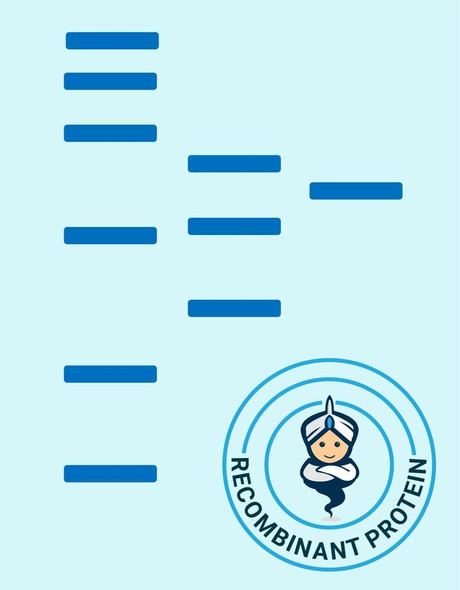Description
| Product Name: | Human FABP1 Recombinant Protein |
| Product Code: | RPPB3487 |
| Size: | 10µg |
| Species: | Human |
| Target: | FABP1 |
| Synonyms: | Fatty acid-binding protein 1 liver, L-FABP, FABPL, FABP-1, FABP1, Z-protein. |
| Source: | Escherichia Coli |
| Physical Appearance: | Filtered White lyophilized (freeze-dried) powder. |
| Formulation: | Filtered (0.4 �m) and lyophilized from 0.5mg/ml in 20mM TRIS and 50mM NaCl, pH 7.5. |
| Solubility: | It is recommended to add 200�l deionized water to prepare a working stock solution of approximately 0.5mg/ml and let the lyophilized pellet dissolve completely. FABP1 is not sterile! Please filter the product by an appropriate sterile filter before using it in the cell culture. |
| Stability: | Store lyophilized protein at -20°C. Aliquot the product after reconstitution to avoid repeated freezing/thawing cycles. Reconstituted protein can be stored at 4°C for a limited period of time; it does not show any change after two weeks at 4°C. |
| Purity: | Greater than 90.0% as determined by SDS-PAGE. |
| Amino Acid Sequence: | MSFSGKYQLQ SQENFEAFMK AIGLPEELIQ KGKDIKGVSE IVQNGKHFKF TITAGSKVIQ NEFTVGEECE LETMTGEKVK TVVQLEGDNK LVTTFKNIKS VTELNGDIIT NTMTLGDIVF KRISKRI |
FABP1 (Fatty acid binding protein1) encodes the fatty acid binding protein found in liver. FABP1 is composed of ten antiparallel�beta strands that form a barrel with a bigger binding pocket than the other FABPs allowing it to accommodate two fatty acid. This protein binds free fatty acids and their coenzyme A derivatives, bilirubin, and some other small molecules in the cytoplasm; it may be involved in intracellular lipid transport and metabolism.
FABP1 Human Recombinant produced in E.Coli is a single, non-glycosylated, polypeptide chain containing 127 amino acids and having a total molecular mass of 14.2kDa (calculated).
| UniProt Protein Function: | FABP1: Binds free fatty acids and their coenzyme A derivatives, bilirubin, and some other small molecules in the cytoplasm. May be involved in intracellular lipid transport. Belongs to the calycin superfamily. Fatty-acid binding protein (FABP) family. |
| UniProt Protein Details: | Protein type:Lipid-binding Chromosomal Location of Human Ortholog: 2p11 Cellular Component: nucleoplasm; peroxisomal matrix; apical cortex; cytosol Molecular Function:antioxidant activity; bile acid binding; phospholipid binding; long-chain fatty acid transporter activity; chromatin binding; drug binding; fatty acid binding Biological Process: long-chain fatty acid transport; positive regulation of cell proliferation; positive regulation of hydrolase activity; cellular lipid metabolic process; negative regulation of caspase activity; negative regulation of apoptosis; positive regulation of fatty acid beta-oxidation; intestinal absorption |
| NCBI Summary: | This gene encodes the fatty acid binding protein found in liver. Fatty acid binding proteins are a family of small, highly conserved, cytoplasmic proteins that bind long-chain fatty acids and other hydrophobic ligands. This protein and FABP6 (the ileal fatty acid binding protein) are also able to bind bile acids. It is thought that FABPs roles include fatty acid uptake, transport, and metabolism. [provided by RefSeq, Mar 2011] |
| UniProt Code: | P07148 |
| NCBI GenInfo Identifier: | 119808 |
| NCBI Gene ID: | 2168 |
| NCBI Accession: | P07148.1 |
| UniProt Related Accession: | P07148 |
| Molecular Weight: | 127 |
| NCBI Full Name: | Fatty acid-binding protein, liver |
| NCBI Synonym Full Names: | fatty acid binding protein 1, liver |
| NCBI Official Symbol: | FABP1�� |
| NCBI Official Synonym Symbols: | FABPL; L-FABP�� |
| NCBI Protein Information: | fatty acid-binding protein, liver; fatty acid-binding protein 1; liver-type fatty acid-binding protein |
| UniProt Protein Name: | Fatty acid-binding protein, liver |
| UniProt Synonym Protein Names: | Fatty acid-binding protein 1; Liver-type fatty acid-binding protein; L-FABP |
| Protein Family: | Fatty acid-binding protein |
| UniProt Gene Name: | FABP1�� |
| UniProt Entry Name: | FABPL_HUMAN |






